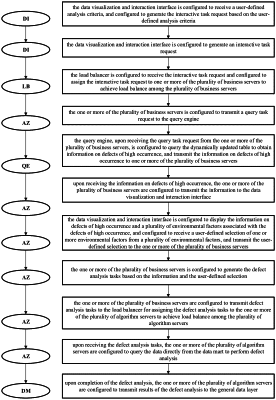| CPC G05B 19/41875 (2013.01) [G05B 19/4183 (2013.01); G06F 18/214 (2023.01)] | 14 Claims |

|
1. An intelligent defect analysis system, comprising:
a distributed computing system comprising one or more networked computers configured to execute in parallel to perform at least one common task;
one or more computer readable storage mediums storing instructions that, when executed by the distributed computing system, cause the distributed computing system to execute software modules;
wherein the software modules comprise:
a data manager configured to store data, and intelligently extract, transform, or load the data;
a query engine connected to the data manager and configured to query the data directly from the data manager;
an analyzer connected to the query engine and configured to perform defect analysis upon received a task request, the analyzer comprising a plurality of business servers and a plurality of algorithm servers, the plurality of algorithm servers configured to query the data directly from the data manager; and
a data visualization and interaction interface configured to generate the task requests;
wherein the data visualization and interaction interface comprises an automatic task sub-interface configured to receive input of the recurring period for which the defect analysis is to be performed;
wherein the task request is an interactive task request;
the data visualization and interaction interface is configured to receive a user-defined analysis criteria, and configured to generate the interactive task request based on the user-defined analysis criteria;
upon receiving information on defects of interest, the one or more of the plurality of business servers are configured to transmit the information to the data visualization and interaction interface;
the data visualization and interaction interface is configured to display the information on defects of interest and a plurality of environmental factors associated with the defects of interest, and configured to receive a user-defined selection of one or more environmental factors from the plurality of environmental factors, and transmit the user-defined selection to the one or more of the plurality of business servers; and
the one or more of the plurality of business servers are configured to generate the defect analysis tasks based on the information and the user-defined selection;
wherein one or more of the plurality of algorithm servers is configured to perform: a computer-implemented method of evaluating likelihood of defect occurrence, comprising:
obtaining original data on defects occurred during a fabrication period;
pre-processing the original data to obtain pre-processed data;
extracting features from the pre-processed data to obtain first features;
selecting second features from the first features;
inputting the second features into a predictive model; and
evaluating likelihood of defect occurrence;
wherein extracting features from the pre-processed data comprises performing at least one of time domain analysis and frequency domain analysis on the pre-processed data;
wherein the predictive model is trained by:
obtaining training original data on defects occurred during a training fabrication period;
pre-processing the training original data to obtain pre-processed training data;
extracting features from the pre-processed training data to obtain third features;
selecting fourth features from the third features; and
tuning parameters of an initial model using the third features to obtain the predictive model for defect prediction;
wherein extracting training features from the pre-processed training data comprises performing at least one of time domain analysis and frequency domain analysis on the pre-processed training data;
wherein tuning parameters of the initial model comprises evaluating a F measure according to Equation (1):
 wherein Fβ stands for a harmonic mean of precision and recall, P stands for precision, R stands for recall, β stands for a parameter that controls a balance between P and R.
|